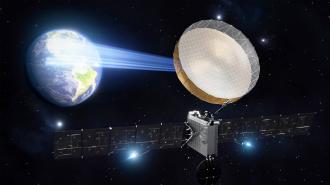Satellite internet startup Astranis is on a mission to help everyone in the world get online — and it just unveiled the satellite that could be the key to its success.
The digital divide: An internet connection means access to jobs, education, entertainment, and more, but nearly 3 billion people aren’t online, and many others still don’t have fast, reliable service.
“They have smartphones just like we do, but those smartphones are still stuck on a 2G internet connection,” John Gedmark, co-founder and CEO of satellite internet company Astranis, told Freethink. “You know, the equivalent of dial-up.”
Though cost is a barrier for some people, others live in remote or rural places where they couldn’t get high-speed internet even if they could afford it — the infrastructure simply isn’t in place, and internet providers aren’t interested in building it.
Satellite internet: Thanks to the falling cost of rocket launches, the cheapest way to close this digital divide may be through satellites, which can beam high-speed internet down to any location on Earth as long as there’s a direct line of sight between the satellite and a receiver.
Other companies, like Starlink, have already been pursuing this for years, but they place their satellites into low-Earth orbit, which is about 340 miles above Earth. Astranis plans to put internet satellites into geosynchronous equatorial orbit (GEO), which is more than 22,000 miles above the ground.
This higher orbit means one satellite can “see” more of the planet’s surface, and as a result, fewer satellites can provide coverage to a larger area. (The downside of the extra distance is that it takes longer for the signal to travel, so GEO satellite internet isn’t ideal for applications that require low latency, like online gaming.)
What’s new? Astranis launched its first satellite in April 2023, and though it was initially working “perfectly,” an issue with a solar array put it out of commission before it could start providing internet access to people in Alaska, as was originally planned.
The company already has orders to deploy nine more satellites over the next two years, though, and on April 10, it unveiled a new, larger model called “Omega.”
According to Astranis, Omega will be able to provide 50 gigabits per second (Gbps) of bandwidth, four or five times more than its original “MicroGEO” model’s 10-12 Gbps. It’s just 50% heavier (400 kg vs 600 kg), though, which helps keep launch costs down.
“Astranis Omega [is] a broadband communications system with better pound-for-pound performance than any other geostationary satellite in orbit today,” wrote Gedmark in a blog post.
Looking ahead: Astranis expects to deploy its first Omega satellite in 2026, with each one having a lifespan of about 8-10 years. As is the case with its MicroGEO satellites, the startup plans to operate the Omega satellites itself, leasing their broadband capacity to customers across the globe.
“There are 3 to 4 billion people in the world that do not have reliable access to broadband internet…And that’s what we’ve gotta fix,” said Gedmark.
We’d love to hear from you! If you have a comment about this article or if you have a tip for a future Freethink story, please email us at [email protected].






